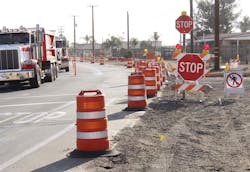Each U.S. presidential election year comes with its own air of uncertainty, but this year, that uncertainty has been compounded by a global health crisis, a nation divided, and adapting to a new way to conduct business.
Included in the ranks of the nation’s essential, front-line workers, the trucking industry has been the glue holding the economy together over the course of the pandemic, but there is a lot at stake for the industry heading into the Nov. 3 election. Possible changes to federal hours of service (HOS) rules under a new administration, addressing the nation’s crumbling infrastructure, and hair testing for drugs and alcohol are just a few top-of-mind items for trucking industry stakeholders.
So, what should the industry anticipate under a second term of President Donald Trump? What regulatory changes could occur under a President Joe Biden? Or, to make things even more interesting, what if Trump wins reelection but Democrats take over the Senate?
No matter how the election plays out, trucking is a bipartisan industry, with representatives in every congressional district across the country. Regardless of who is elected president or to the legislative branch, trucking associations and key players in the industry intend to keep the focus on their top priorities.
“Trucking is a durable industry, and as we’ve seen during this pandemic—we are essential,” said Bill Sullivan, executive vice president of advocacy for the American Trucking Associations (ATA). “Because of that, we are confident we will be in a strong position to prosper regardless of what happens in November.”
ATA has, however, already begun its work to understand what changes under a new President Biden or a second term of President Trump could mean for the industry.
“Much like we did in 2016, we’ve begun talking to the potential Biden transition team about what their priorities are going to be and how we can work with them on those,” Sullivan explained. “And we’ve had three-plus years of working with the Trump administration to know what issues they deem important. Both sides have signaled support for infrastructure investment. So, we will work with them on that and hold them to their rhetoric about the importance of investment in our roads and bridges.”
“Generally speaking, if there is a change in administration, Democrats tend to be more supportive of regulation, especially environmental and safety rules,” Sullivan added. “ATA can and does support regulatory efforts in these areas, provided they are backed by strong data. We will work with either side because trucking is bipartisan—we will support policymakers who support us.”
A second Trump term
If President Trump wins a second term, the administration will likely first focus on filling key vacancies as quickly as possible, explained Dave Osiecki, president and CEO of Scopelitis Transportation Consulting, during Trimble’s 2020 virtual in.sight user conference and expo. One of those vacancies could end up being a permanent replacement for Jim Mullen, former acting administrator of the Federal Motor Carrier Safety Administration (FMCSA), who announced his departure from the agency in August. James Wiley Deck has since taken on the role of deputy administrator for FMCSA.
The Trump administration will also continue its focus on infrastructure, Osiecki said. The Fixing America’s Surface Transportation (FAST) Act was set to expire at the end of September without the likelihood of a reauthorization due to the November election.
“I say that a bit skeptically because, let’s face it, this administration said we are going to focus on infrastructure and spend $2 trillion, and this administration hasn’t been able to get that done,” Osiecki relayed. He added that a second term of President Trump will likely continue to focus on regulatory reform.
In the first six to 12 months of President Trump’s current term, the administration placed a significant amount of focus on regulatory reform and relief, and on many issues that the trucking industry deems important.
The Trump administration, for instance, pulled the safety fitness rule off the table, and stopped both the trucking insurance limit rulemaking and sleep apnea ruling in their tracks. In addition, the administration focused on making commercial driver’s license (CDL) rules more driver friendly for those trying to obtain their CDLs. The Trump-led Department of Transportation (DOT) also developed the addition of the permanent crash preventability program under the Compliance, Safety, Accountability (CSA) program, and revised federal HOS rules to make these programs more business and industry friendly, explained Osiecki.
One of the Trump administration’s biggest trucking-related efforts has been the overhaul of the federal HOS rules, which has been widely supported across the trucking industry. The Owner-Operator Independent Drivers Association (OOIDA), however, is nervous about what could happen depending on how the election plays out.
“To be candid, no administration has been good for small-business truckers over the last several decades,” explained Mike Matousek, OOIDA’s director of government affairs. “What gives us pause or concern is Congress has delegated a tremendous amount of authority to the executive branch throughout the years, and that’s especially true at DOT. DOT, with some exceptions, can basically propose anything they want. We have seen that over the years. The Obama administration was considering a speed limiter mandate and didn’t get far along in the process. They were also looking at options to increase the federal insurance requirements.”
Throughout the pandemic, FMCSA has been lauded for its thorough communications efforts of COVID-19-related issues, as well as HOS and CDL challenges, to the industry. The agency has also made it a point to listen to industry concerns and feedback.
“If President Trump wins re-election, we can certainly expect to see more expedited processes, which we are experiencing right now with COVID,” explained David Heller, vice president of government affairs for the Truckload Carriers Association (TCA). “You can expect a lot of that red tape to be removed if President Trump is re-elected.”
Heller also emphasized that it’s not just about focusing on who gets into the White House.
“Quite frankly, it would be even more interesting if Trump retains the White House and then the Senate swings Democrat,” Heller noted. “It is an interesting political world right now.”
A Biden presidency
If Biden does win the upcoming presidential election, there will be a transition and a building out of the management team’s agenda and agency review teams. Biden and his team will look for rules that don’t meet the new administration’s criteria and will look to stop those rules through an executive order shortly after inauguration, Osiecki said.
Looking ahead, what might a Biden-led DOT and trucking policy agenda look like?
“You don’t have to look very far or much beyond the House-passed INVEST Act,” explained Osiecki. “It was passed at the House and is dead on arrival at the Senate, so I actually don’t think it will be passed by the U.S. Congress and make it to President Trump’s desk before the election. That bill is chock-full of Democratic transportation priorities. If Biden wins in November, these things will likely be on his DOT policy agenda no matter who he puts in the seat at the FMCSA or Department of Transportation.”
One of the most controversial elements of the Democratic-led House infrastructure bill is an amendment that would raise the minimum insurance requirements on commercial vehicles from $750,000 to $2 million. The measure also includes a speed limiter mandate, regulating driver detention time and pay, upgraded rear trailer underride guards, side underride guards on trucks and trailers, making CSA public, CSA safety fitness ratings, sleep apnea screening criteria, and a possible rollback of the Trump administration’s HOS changes.
“Hours of service is a political football,” Osiecki pointed out. “When the Democrats are in charge of the White House, they typically try to make these rules more conservative, meaning less flexible. When the Republicans are in the White House, they typically try to make the hours of service rules a little more liberal and flexible, which is exactly what they tried to do with what is going to take effect in September.”
For OOIDA, a major concern is that the new HOS rules are generally partisan with very little support from Congressional Democrats. Another major concern for the organization’s members is underride guards for trucks and trailers, as there are a few Republicans, but mostly Democrats pushing that issue.
“If there is a Biden administration, our obvious concern would be what would they do to the new hours of service regulations that went into effect at the end of September,” Matousek said. “If that rulemaking was still pending when Biden was sworn into office, one of the first things I think new administrations do is pause any pending rulemakings via an executive order. That’s why we are optimistic that the new hours of service rules actually took effect on Sept. 29. The biggest question is what would a Biden administration or a Democratic-controlled Congress do with the rules? Would they reverse the rules? We don’t really know that.”
OOIDA also expressed its concern that the previous Obama administration was considering a speed limiter mandate and insurance requirement increases.
“We would absolutely be concerned that another administration—whether it’s Biden or someone else behind Trump—would push that,” Matousek said. “At least, for the time, with the Trump administration, we know they are not going to push the speed limiter mandate. We know they are not going to increase federal insurance requirements. It’s sort of a known thing.”
Based on Biden a presidency and the potential for Democratic control of Capitol Hill, Heller explained that the industry has to be prepared to get involved in conversations like minimum insurance rates, sideguard or underride protections and what CSA could look like over the next year.
“CSA is not going away, and we don’t want it to go away, but we do want it to be correct,” Heller advised. “Looking at a safety measurement program that might be inaccurate is not good for the industry. The industry should insist that those scores be accurate in their determination.”
Heading into 2021
As the nation’s infrastructure continues to degrade, heading into 2021, ATA’s Sullivan expressed the importance of seeing a real increase in investment in U.S. roads and bridges.
“As we try and recover from the COVID-induced recession, a well-funded highway bill will create millions of needed jobs to rebuild not just our infrastructure, but our economy,” Sullivan said.
Moving ahead, ATA is prioritizing legal reform and “pushing back on trial lawyers who have begun using our industry as a piggy bank in recent years,” Sullivan added.
Throughout the COVID-19 pandemic, the industry has recognized firsthand how regulatory flexibility can benefit the supply chain, particularly when it comes to temporary measures around HOS, licensing and driver training.
Heller, who also reiterated the need for a stronger infrastructure plan that will help abate congestion on the nation’s roadways, pointed out that COVID-19 has shown the need for the industry to operate unimpeded and without as much traffic.
“The majority of TCA’s members that have operated in this COVID time have done so without the emergency declaration and have had no need to operate outside the HOS regulations because nobody is on the highway,” Heller said.
Regardless of who is elected, a top priority for TCA is moving the needle on hair testing for drugs and alcohol.
“We are a zero-tolerance industry, and in order to continue that mantra, we have to continue to incorporate that form of testing,” Heller emphasized. “We need an alternative testing to urine to allow carriers to pass their DOT qualifications. There are carriers using hair as part of their daily testing, but they are not using it for everyday DOT testing protocols. Quite frankly, there should be that need and getting the results of those test into the Drug & Alcohol Clearinghouse is paramount. We have to know what kind of drivers we are getting when we are bringing them on board, and if the ability to do so is there, why not incorporate that into the DOT process.”
If Congress ends up being led by Republicans, OOIDA has its eyes set on advocating against an increase in truck size and weights, as well as allowing 18-year-old CDL holders to operate across state lines. In addition, regardless of who is elected, one of OOIDA’s highest priorities on the legislative side is advocating for the Truck Parking Safety Improvement Act. The bill, also known as H.R.6104, directs the DOT to set aside certain funds through fiscal year 2025 to provide parking for commercial motor vehicles on the federal-aid highway system.
“It will be a priority of ours moving forward,” Matousek said of the bipartisan bill. “We are still building support for that on a daily basis.”
During the pandemic, the Trump administration issued various waivers and emergency declarations to provide HOS relief for commercial drivers. Industry stakeholders have expressed the need for Congress to continue taking those actions into consideration and encouraging trucking companies and industry representatives to communicate with their lawmakers on a regular basis, despite who is elected into the Oval Office.






